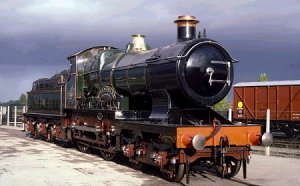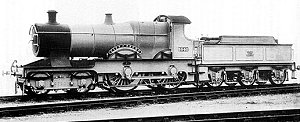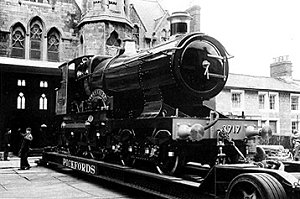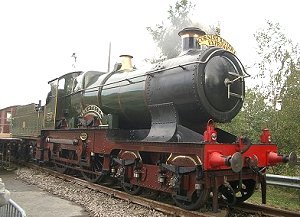The City of Truro
Swindon world record-breaking locomotive
Even in a world where we have become accustomed to giant leaps by mankind, it is still easy to see that May 9th, 1904 was one of those special days when people woke up in one era and went to bed in another.
It was on that day, a hundred years ago, that Swindon and the unlikeliest of its homespun heroines changed the world forever. At around 10.45am on that spring morning, the Swindon-built City of Truro became not only the first locomotive to reach and pass the magical speed of 100mph, but the first vehicle of any kind to reach such a milestone. No wonder the story was to turn into something of a transport legend and take on a life of its own, turning into a mystery tale that people would still be arguing over, a century later. The irony is that, if she could talk, you sense that the City of Truro might blush about the whole affair and tell everybody not to make such a fuss. This grand old lady of our railway heritage would certainly have been acutely embarrassed by the scandal surrounding her mis-spent youth. It's traditional to refer to locomotives as female, but rarely does it seem more fitting than with the City of Truro. She comes from - indeed she marks the end of - an era when true elegance reigned and she certainly didnıt belong in the company of the next generation of steam-powered beasts with their tendency towards sheer brute force. But she and her sisters - the Great Western Railway's remarkable little 'City class' of engines - were certainly flighty for their day. By 1904 they were building a reputation for speed, and as observers began to reach for their stopwatches, the question was whether or not the world would have to wait for the new generation before they would see the 100mph barrier broken.
And so it was on May 9th that the City of Truro picked up a train of 'ocean mails' recently arrived at Plymouth on a trans-Atlantic steamer from San Francisco, and made ready for the 128-mile trip to Bristol, from where she was later bound for a stop at Swindon, en route to London.
There were around 1,300 large bags of mail on board, packed into five heavily laden eight-wheeled postal vans, including an even larger sorting van. The whole load was estimated at 148 tons, not including the engine and tender (another 90 tons). The journey's timekeeper, Charles Rous-Marten, tells us that the driver was called Clements and that he was 'a very smart man', but omits to tell us his first name. The historic leg to Bristol began at 9.23am and would take just over two hours, giving us an average speed of 62mph. But it was the descent between Whiteball Tunnel to Wellington, just west of Taunton, that would make this a barrier-breaking day because it was on that short section of just a few minutes that the train reached its top speed of 102.3mph. Timekeeper Rous-Marten complained about 'some foolish platelayers' staying too close to the track when the 'lightning express' was nearly on them, which nearly spoiled everything, but he tells us nothing of the atmosphere in the cab or whether the driver realised what he had achieved. His timings were, nevertheless, meticulous as he recounteds the journey in detail in an article for The Railway Magazine, a month later. Rous-Marten only refers to the trip setting what he calls 'the record of records', failing to highlight exactly what record or barrier had been broken. This was under the instructions of the GWR who had become sensitive to public feeling about time trials. Feelings were running high after the derailment of a night tourist train at Preston, and although the GWR and the rival London and South Western Railway were locked in a race with one another for the ocean mails traffic, they had no intention of admitting to actions which some might have considered reckless, even if it proved they were world-beaters. As Rous-Marten told the magazine's readers: "It is not desirable at present to publish the actual maximum rate that was reached on this memorable occasion."
It wasn't until December 1907 - three and a half years after the run - that The Railway Magazine finally published a table of maximum speeds recorded for various classes of locomotive. Even then it took a certain amount of deduction to understand that the top speed was accredited to the City of Truro. This fact was finally confirmed in the magazine's April 1908 edition - the very month when Rous-Marten died suddenly of a heart attack.
It would still be a further 14 years before the GWR would officially lay claim to the record, by which time debates over the validity of the late Rous-Marten's timings were raging. And they are raging still. Some have pointed to City of Truro's 1,000 horse power and calculated that it was physically impossible for such an engine to notch up any more than 92mph on that section of the track. Others have even suggested that the fiery temperament of Rous-Marten made him an unreliable referee! Astonishingly, it would be another 30 years before another locomotive - the Flying Scotsman - recorded a speed in excess of 100mph which would be universally acknowledged, but surely the longer the argument over the City of Truro's credentials as the first 100mph engine goes on, the more futile it gets. It is the City of Truro's name that has gone down in history and, perhaps most significantly, no less an authority than the UKıs National Railway Museum at York acknowledges that the prize belongs to her. The real point, surely, is that a lady's reputation is often more important than her actual deeds. Whether or not the City of Truro actually did go through the 100mph barrier on May 9, 1904, the rest of the world believed she was capable of it - that mankind was now able to do it. So who are we to doubt her? Ironically, though the City of Truro had taken us into a brave new world, her record-breaking run actually marked the end of an era as much as it heralded a beginning - and in more ways than one. She certainly represented the past rather than the future of locomotive design.
George Jackson Churchward had recently taken over as the GWR's Locomotive Superintendent - the very top job in Swindon's mighty railway works - and the City of Truro was one legacy of a difficult period in which he slowly took over from the ailing William Dean, his predecessor and former boss. The City of Truro was, unmistakably, a Dean-designed engine with Churchward's tweaks - most notably a larger boiler. You don't need to be an engineer to see how the City class differed radically from what was about to emerge from the drawing board of Churchward, who is arguably the GWR's most celebrated engineer after Brunel. Wheel configuration is one key. The City class had a 4-4-0 arrangement (with four smaller wheels at the front and four larger drive wheels behind), which was already starting to give way to Churchwardıs pioneering 4-6-0s. Another of Churchward's innovations was the move to external cylinders which, as well as providing greater power, also allowed for much more flowing, racy, modern lines. It gave us the classic outline of steam locomotives as we remember them today - icons of a golden age championed by Churchwardıs designs. Quickly superseded she may have been, but the City of Truro would not easily be forgotten. Indeed, her immortality as one of the most illustrious players in our industrial history is now assured. Generations of young railway enthusiasts already know her as one of the very few real engines to shunt alongside fictional favourite Thomas the Tank Engine in the Rev Awdry's ever-popular books, and they will have every chance to see the grand old lady speed off the page and into real life in her second century. While all other City class locos ended up on the scrapheap, the City of Truro was preserved because she had a record-breaking pedigree - and her future now looks brighter than ever. A £130,000 refit, which was completed in February 2004, ensured that she would celebrate the centenary of her greatest hour in the best possible fashion - under her own steam. Back in Swindon... Train enthusiasts and GWR historians were especially pleased when City of Truro returned to Swindon in September 2004, as the main attraction of the Great Western Steam Convention.
It was great to have her back home.
See below for a video of City of Truro making a special guest appearance at the Swindon & Cricklade Railway.
1. As well as mail, the City of Truro was carrying bullion on its record-breaking run in 1904. This was a payment by the Americans to the French for ongoing work on the Panama Canal. 2. The City of Truro was one of 20 City class locomotives built by the GWR at Swindon - half of which had been converted from the earlier Albata class. 3. 1904 was an important year for another form of transport in Swindon. September was to see the opening of the town's tram system. More on Trams 4. The City of Truro had a relatively short working life (as steam locomotives go). Built in 1903, she was taken out of service in 1931. 5. The City of Truro was due to be one of the centrepieces of the National Railway Museum's Railfest 2004 - a major event celebrating a number of railway milestones, in York from May 29th until June 6th, 2004. 6. The City of Truro was originally numbered 3717 but had been renumbered as 3440 by the time of her 100mph run. 7. The GWR's Chief Mechanical Engineer Charles Collett asked that the City of Truro be preserved at the then new National Railway Museum at York when she was retired in 1931. She remained as a static display until 1957, when she was restored to working order to haul special trains. She was taken to Swindon's GWR Museum in 1962 where she stayed until 1984, when she was restored for the GWR's 150th anniversary celebrations the following year. After that, she returned to the National Railway Museum where she was occasionally used on mainline outings. She made a guest appearance in an exhibition called National Railway Museum on Tour which visited Swindon in 1990. 8. The City of Truro's four driving wheels are each 6ft, eight-and-a-half inches in diameter. 9. The City of Truro's latest refit was carried out at Derby by Halcrow, who are also a local employer (as they have a site at Wroughton). It was an initiative by her owners, the National Railway Museum, who teamed up with Steam Railway Magazine, the Gloucestershire Warwickshire Railway and the Bodmin & Wenford Railway to bring the project to fruition. More on restoration 10. The current refit is expected to keep the City of Truro in working order for about seven years - after which she will retire to the National Railway Museum at York. |
|
||||||||
|
||||||||
|
||||||||
|
||||||||
|
||||||||
|
||||||||
|
||||||||
|
||||||||
|
||||||||
|
||||||||
|
||||||||
| STEAM | ||||||||
























